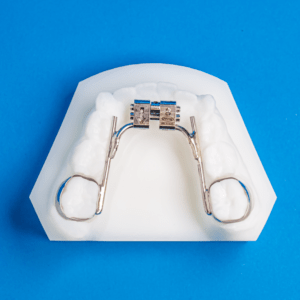Available in 3D Printing?
- Yes
Arch Options
- Upper
 Lab Login
New Account
Lab Login
New Account
We make the basic Transpalatal Arch using a .036-inch wire with a center loop. It’s soldered to the molar bands, as shown.
The palatal wire must be relieved from the tissue for patient comfort. You may insert a fixed transpalatal as a passive appliance or make slight adjustments to widen or rotate the molars.
There are 48 activations on the standard RPE; each activation is equal to 1/4 millimeter.
Ordont™ carries most manufacturers' screws. They include Leone, Dentaurum, Forestadent, Super Screw, and Summit.
Ordont™ was the inventor of the RES (Ratcheting Expansion Screw). We also offer the Dentaurum "Click", and the Forestadent "Snap-Lock".
The Dentaurum MiniPalex Screw (also known as the Variety) is the most commonly-used expansion screw.
It has 12 millimeters of expansion capability and is half the size of the traditional RPE screws.
The Rapid Molar Distalizer has proven to be a very effective distalizing appliance. The distalization is controlled by the expansion screws in 1/4 millimeter increments.
The standard cage-style thumb habit works on most patients. We also make the rake style for the determined thumb habit patients.
We use the vertical habit cage with a pearl in the vault of the palate. This will stop the tongue habit and also retrain the tongue.
At Ordont™, we fit bands, crowns, and ROC "Removed Occlusal Crowns" on about 60% of all the metal appliances we construct. This saves time for the doctors and staff.
The Lower Fixed Expander is the most commonly used lower expansion appliance. The Quad Helix, Frozat, and J.I. Williams expander are frequently requested as well.

The Pendulum has a Nance button, and occlusal rests on the fir...
Read more
The HTH Telescoping Herbst is the bulkiest appliance on the ma...
Read more
The JI Williams uses tubing on the lingual surface of the lowe...
Read more
The Fixed Quad Helix is attached to the first molars on either...
Order Now